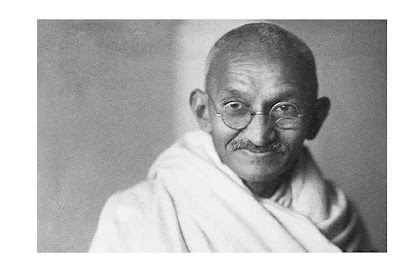MOHANDAS K. GANDHI DID NOT COIN THE SAYING "LOVE THE SINNER, HATE THE SIN"!
“'Hate the sin and not the sinner' is a precept which, though easy enough to understand, is rarely practiced, and that is why the poison of hatred spreads in the world.”1
Is it true that Gandhi coined the saying?
No.
But in defense of the meme-makers the saying is regularly...very regularly...wrongly attributed to Gandhi. And besides being misattributed it is also regularly...again very regularly...misquoted as well as
"Hate the sin and love the sinner."
What Gandhi actually said was:
"Hate the sin and not the sinner."
Gandhi quoted the saying. Indeed it might be said to have served as the bedrock of his activism, as it was for Martin Luther King Jr's after him. But that Gandhi did not coin the term is already indicated in the passage itself by the fact that Gandhi puts it in quotation marks and refers to it as a "precept." Both point to the saying's having been a familiar one before Gandhi.
And, indeed, it was.
“The trite saying, ‘Hate the sin, but love the sinner;' most expressly conveys our whole feeling. Envy, hatred, malice, and all uncharitableness, have no dwelling in hearts devoted to the Gospel of Peace, Goodwill, and Joy.”2
The same is indicated by the fact that other Indian teachers before Gandhi quoted it as well.
So, for example, Swami Rama Tirtha (died 1906) had earlier quoted the saying, referring to it as "old":
“There is an old saying 'Hate sin but not the sinner.' Now, is it practical to hate the sin and love the sinner; is it practical? Yes, it is very practical.”3
Swami Vivekananda (d. 1902), star of the 1893 Chicago Congress of World Religions, also quoted the saying. But in his case he rejects its validity:
"You hear fanatics glibly saying, 'I do not hate the sinner, I hate the sin;' but I am prepared to go any distance to see the face of that man who can really make a distinction between the sin and the sinner."4
But references to it were by no means limited to India, nor did it originate there. So, for example, the American novelist Upton Sinclair used it before Gandhi, putting it on the lips of a character in a 1922 novel:
“I hate the sin but love the sinner.”5
Similarly, the Irish painter John Butler Yeats, father of the better-known William Butler Yeats, wrote in 1914:
"It is only the great
sinner who can do the two things of hating the sin and loving the sinner; the
other sort only hate the sinner" (May 10 1914).6
Better informed writers generally mention that the 4th/5th century writer Augustine of Hippo already had a version of it:
"...with love toward men and hatred of sin” (cum dilectione hominum et odio vitiorum). (Epistle 211.11)
But they tend to jump forward from Augustine to Gandhi's 1929 quotation without showing awareness of anyone's using it in between.7 But indeed many examples might be cited.
The 5th/6th century Rule of St. Benedict, which continues to serve as the basis for Benedictine monastic life down to the present, says of the Abbot,
“he must hate sin but love the brothers (oderit vitia, diligat fratres) (sec. 64.11)
"Thus do all those that when they should hate the sin of their fellow-Christians and love the person, they hate the person instead of [the] sin, and think that they hate the sin."
(Thus doon alle thoo that whanne thei schulden hate the synne of here even Cristene and love the persoone, thei hate the persoone instide of synne, and wene that thei hate the synne).8
Similarly, the 14th/15th century Middle-English writer Julian of Norwich, in her Showings writes how we should,
(nakidly hate synne and endlesly loven the soule as God lovith it; than shal we haten synne lyke as God hatith it, and love the soule as God lovyth it).9
The 17th century Puritan Thomas Manton similarly writes:
“Their ordinary prayers are against the plots rather than the persons of their enemies: Diligunt in inimico naturam, non vitium; “they can love the nature, though they hate the sin.”10
Then in the 18th century, Charles Wesley, one of the Church's greatest hymn writers, included the saying in a hymn:11
The saying was very common in the 19th century. So, for example, Gandhi was born in 1869, but already in 1865 Charles Kingsley published a book of sermons in which he suggested that King David, when calling down curses on his enemies, had not,
“learnt to hate the sin and yet love the sinner.”12
"On the whole we cannot but think that there was much Christian wisdom in the remark, which we have before quoted, of a poor old slave-woman, whose whole life had been darkened by this system, that we must “hate the sin, but love the sinner.”13
"If zeal be true, it will be a zeal tempered with charity and love. It will not be a bitter zeal. It will not be a fierce enmity against persons. It will not be a zeal ready to take the sword, and to smite with carnal weapons. The weapons of true zeal are not carnal, but spiritual. True zeal will hate sin, and yet love the sinner. True zeal will hate heresy, and yet love the heretic. True zeal will long to break the idol, but deeply pity the idolater. True zeal will abhor every kind of wickedness, but labor to do good even to the vilest of transgressors. True zeal will warn as St. Paul warned the Galatians, and yet feel tenderly as a nurse, or a mother over erring children."15
The Prince of Preachers Charles Haddon Spurgeon, whose Reformed convictions are well known, also uses the saying:
“When thou hatest the man's sins, thou art not to hate him, but to love the sinner, even as Christ loved sinners and came to seek and save them.”16
Spurgeon also includes the saying in his book Salt-Sellers, which is a collection of sayings and proverbs:
“A good distinction: hate
the sin, but love the sinner.” 17
These are just a few examples of what I suspect are dozens or even hundreds prior to Gandhi’s use of the saying. It's good to remember that Gandhi’s India was under the British, and that Gandhi himself studied in England. Gandhi also knew a number of Christians. Prominent among these was one of his closest friends, C. F. Andrews, who was an Anglican priest. He also had interactions with a number of Plymouth Brethren and had even heard about the missionary work of George Mueller of Bristol. He heard Andrew Murray preach and met him.18 Murray himself wonderfully summed up what Christians mean when they use the saying:
"We see sin unspeakably hateful in its awful guilt against God and its fearful power over the poor soul: we see sin condemned, atoned, put away, and conquered in Jesus. We learn to look on the world as God looks upon it in His holiness: hating its sin with such an infinite hatred, and loving it with such a love, that He gives His Son, and the Son gives His life, to destroy it and set its captives free."19
1. M. K. Gandhi, An Autobiography, or The Story of My
Experiments with Truth (trans. Mahadev Desai; Ahmedabad: Navajivan,
1927-1929), 254. The passage had already appeared in the serialized version of
Gandhi's autobiography in a weekly journal edited by Gandhi called Young India (9.28
[July 14, 1927]: 225), and “The Story of My Experiments with Truth [The
Autobiography of Mahatma Gandhi] Part iv-Chapter ix,” Unity C.11 (Nov 21, 1927), 176.
2. John C. Kenworthy, Christian Revolt Essays and Addresses (London: William Reeves, 1893), 4.
3. Swami Rama Tirtha (d. 1906) In Woods of God Realization, or The Compete Works of Swami Rama Tirtha Volume II, Pts. 4-5: "The Fountain of Power" (2nd ed.; Dehli: Amir Ohand, 1913 [orig. 1911), 163.
4. Swami
Vivekananda, Karma-Yoga (Calcutta: Udbodhan Press, 1901), 102.
5. Upton Sinclair, They Call me Carpenter: A Tale of the Second Coming (Chicago: The Paine Book, 1922), 103.
6. Passages from the Letters of John Butler Yeats: Selected by Ezra Pound (Churchtown Dundrum: The Cuala Press,1916), 37.
7. In the New Yale Dictionary of Quotations, for example, Augustine’s version is given, along with the statement “Famous in the form “Love the sinner but hate the sin,” after which the reader is referred to Gandhi’s version as it appeared in his autobiograpy. When one consults the entry with Gandhi’s version, they are likewise referred to Augustine’s (The New Yale Dictionary of Quotations [rev. ed.; ed. Fred R. Shapiro; fwd. Louis Menand; New Haven & London: Yale University Press 2021], 36, 313).
8. The Middle-English text of Hilton's Scale available
at https://d.lib.rochester.edu/teams/text/bestul-hilton-the-scale-of-perfection-book-i.
9. The Middle-English text of Julian of
Norwich's Shewings available
at https://d.lib.rochester.edu/teams/text/the-shewings-of-julian-of-norwich-part-2.
10. Thomas Manton, A Practical Commentary
of an Exposition with Notes on the Epistle of James (London: R. Gladding, John
Gladding, and Hamilton, Adams, 1840), 435.
11. The Poetical Works of John
and Charles Wesley: Reprinted from the Originals, With the Last Corrections of
the Authors; Together with the Poems of Charles Wesley Not Before Published,
Vol. III (ed.
G. Osborn, London: Wesleyan-Methodist Conference Office, 1869), 79.
12. Charles Kingsley, David:
Five Sermons: Preached before the University of Cambridge (London:
Macmillan, 1865), 54.
13. Harriet Beecher Stowe, A Key to Uncle Tom’s Cabin (Boston, MA: John P.
Jewett / Cincinnati, OH: Jewett, Proctor and Worthington/London: Low, 1853), 255,
also 167.
14. D. L. Moody, Glad Tidings, Comprising Sermons and Prayer-Meeting
Talks. Delivered at the N.Y. Hippodrome (New York: E. B. Treat,
1876), 330; Robert Boyd, The Lives and Labors of Moody and
Sankey (intro. John Potts; Toronto: A. H. Hovey, 1876), 370.
15. J. C. Ryle, The Priest, the Puritan, the Preacher (New York: Robert Carter, 1836), 316.
16. C. H. Spurgeon, "Sermon 208: Righteous
Hatred” (Aug 8, 1858), New Park Steet Pulpit 4, 782.
17. C. H. Spurgeon, The Salt-Sellers: Being a Collection of
Proverbs, together with Homely Notes Theron (New York: A. C. Armstrong, 1889),
205.
18. Gandhi, Autobiography, 169-170.
19. Andrew Murray, The Spirit of Christ: Thoughts
on the Indwelling of the Holy Spirit in the Believer and the Church (New
York: A. D. F. Randolph,1888), 119-120.





Comments
Post a Comment